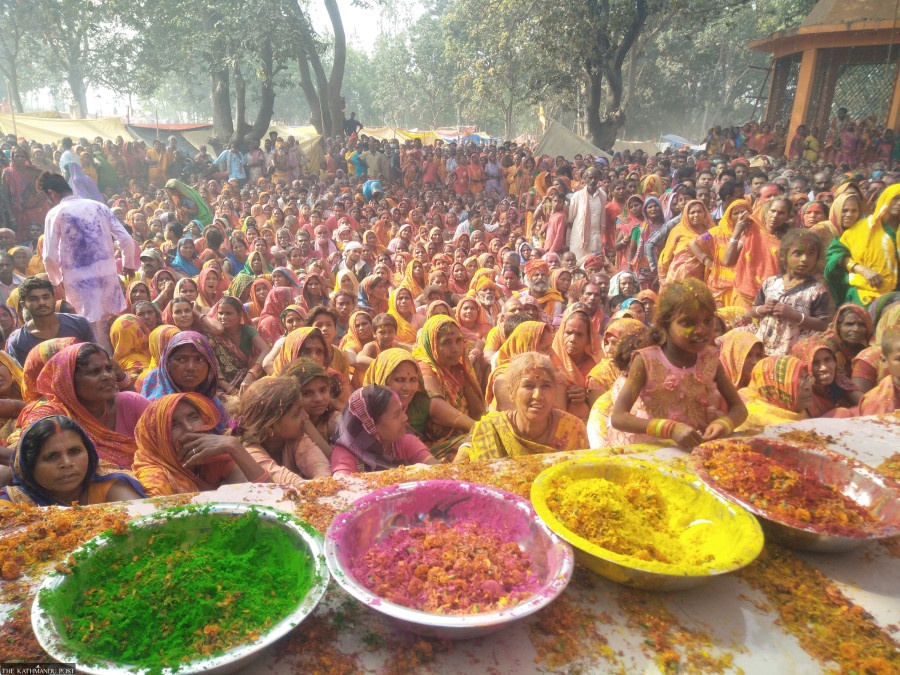Culture & Lifestyle
Holi, the Mithila way
The annual Mithila Madhyamik Parikrama in Janakpur draws devotees from Nepal and India for a 133km pilgrimage.
Aarati Ray
Aarti Devi Ray, a 65-year-old resident of Jogyara, Bideha Municipality in Dhanusha, was eager to join the Mithila Madhyamik Parikrama festival this year. However, due to health concerns, she had to stay home and bid farewell to her neighbours who were attending.
Last year, her circumstances were different. She had made a vow to Kishori ji (Goddess Sita) that if her daughter was blessed with a child, she would participate in the fifteen-day Parikrama (circumambulation). Miraculously, just six days before the Parikrama, her daughter gave birth to a healthy baby.
On Falgun 8 last year (February 20, 2023)—right after the chatiyar (name-keeping ceremony on the sixth day after a child’s birth)—Ray and her husband, accompanied by 14 neighbours, set off to Janakpur for the Parikrama.
Reflecting on the experience, Ray says, “During the Parikrama, I felt as though I was journeying with God. I was immersed in devotion, leaving behind all worldly sorrows and joys.”
Despite the physical challenge of walking barefoot for fifteen days at their age (her husband is 72), Ray and her husband have participated in the Parikrama six times already. Her husband remarks, “With God’s blessings and the atmosphere of faith during Parikrama, all fatigue dissipates.”
The Mithila Madhyamik Parikrama, an annual pilgrimage in ancient Mithila, commences on the day of Amavasya in the Hindu month of Falgun (March 10 this year) and concludes on the day of Purnima or the Holi festival.
The 133 km Parikrama begins at the Mithila Vihari temple in Kachuri, Janakpur. Contrary to common belief, it starts from this small temple rather than the Janaki temple, as explained by Dr Surendra Labh, a retired professor at Ramswarup Ramsagar Multiple Campus in Janakpur and former board member of the Research Policy Institute.
The devotees, led by Mithila Vihari Dola, commence their journey from Kachuri, carrying the first dola (a wooden palanquin carrying idols of gods and goddesses). They pass through various locations, including Thera, Venga Shivpuri, Piradi and rest at Ratnasagar in Janakpur.
After visiting the Janaki Temple, they rest at Hanuman Gadhi in Kuwa Rampur before departing for Kalyaneshwar in India the following morning. The route and bishram asthan (resting place) for the Parikrama are predetermined. The circumambulation starts from Kalyaneshwor and passes through Phulhar, Mathihani, Jaleshwar, Madai, Dhruvakunda, Kanchanban, Parbata, Dhanushadham, Satoshar, Aurahi, Aursaha, Karuna, Bisaul and return to Janakpur on the eve of Fagu Purnima (Holi).
Upon their return, devotees gather at Barah Bigha Maidan (a big open ground near Janaki Temple). Then, they perform the Holika Dahan ritual at Janaki Temple, lighting a bonfire to celebrate the burning of the demoness, Holika. On the morning of the full moon, the fifteen-day religious journey is completed by circumambulating the inside of Janakpur, which is called Antargriha Parikrama.
.jpg)
The Antargriha Parikrama, covering a distance of approximately 16 km, signifies the final leg of the pilgrimage. It concludes at Pidari Chowk, marking the end of the Parikrama. Holi is celebrated the next day, which is March 26 this year.
For those unable to undertake the full Parikrama, participation in the Antargriha ritual holds significance. Bhogendra Jha, a 70-year-old resident of Janakpur, has been a regular participant in this concluding ceremony.
Jha emphasises the spiritual significance of Parikrama, believing that walking through sacred sites brings merit and fulfilment of wishes. Despite the physical challenges, he witnesses thousands of devotees joining the pilgrimage, driven by faith and devotion.
Ray echoes this sentiment, considering Parikrama as a form of penance. Despite enduring physical discomfort and challenges, she finds solace in the sense of communal harmony and selfless assistance among pilgrims and locals.
Throughout the Parikrama, devotees are aided by locals who provide shelter, food, medical assistance, and other forms of support. The pilgrimage serves as a symbol of unity between Nepal and India, transcending political tensions.
The Mithila Madhyamik Parikrama began on March 10 this year, and devotees will reach Janakpur from Bisaul (India) today. Many eagerly anticipate the Antargriha Parikrama scheduled for the following day.
While Ray eagerly awaits the return of her neighbours and relatives to celebrate Holi, Jha, the former vice-chair of the Madhesh Provincial Planning Commission, hopes for greater government support in organising and enhancing the Mithila Madhyamik Parikrama, a symbol of cultural devotion and social harmony. He notes that while the government has made efforts in organising the event, such as road maintenance, it appears to lack depth.
Jha further observes that NGOs, private organisations, and individuals contribute more significantly to the festival. He suggests monitoring and evaluating the budget allocated to the Parikrama to improve future planning and execution.
He advocates for better planning and utilisation of resources to enhance the cultural significance and tourist attraction of the festival.




 7.12°C Kathmandu
7.12°C Kathmandu















